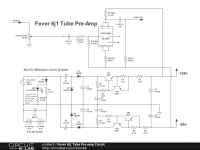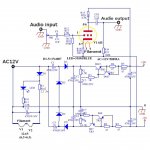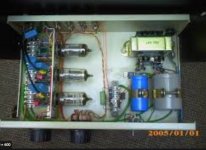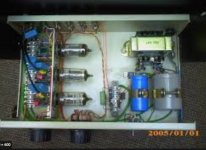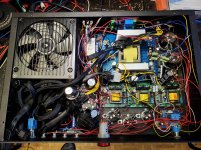From the pictures in post #11 I can make out that there is a load resistor of 4K7 and that the cathode resistor is 220 Ohm. So it is indeed more a preamp than a 'true' buffer.
If I look at the two schematics I could find with more or less the same set-up, I'm puzzled by the dc appearing at the output terminals. The outer contacts of the output terminals are connected to ground, while the inner/signal contacts of the output terminals sit at -28 V (through the 100K resistors). Would that not be problematic if you connect this buffer/preamp to an amplifier without an input capacitor?
But maybe the schematics I found are not correct and/or don't reflect the buffer of TS.
If I look at the two schematics I could find with more or less the same set-up, I'm puzzled by the dc appearing at the output terminals. The outer contacts of the output terminals are connected to ground, while the inner/signal contacts of the output terminals sit at -28 V (through the 100K resistors). Would that not be problematic if you connect this buffer/preamp to an amplifier without an input capacitor?
But maybe the schematics I found are not correct and/or don't reflect the buffer of TS.
Attachments
As I said previously, the device you're listening to is not a buffer, it is a line stage preamp.Starting from the positive listening notes on this small device . . . I dismissed some of my prejudices. In particular with respect to buffers. In short, when well done they can sound very well and perform very well the function of line stages when voltage gain is not necessary (my case). . . . But it made me realize that a buffer can give an extremely musical and pleasant tone to the sound.
The Chinese sellers may call it a buffer in their advertising but that does not make it one. It's a single pentode tube, connected as a triode, that takes its output from the plate (anode). A buffer takes its output from the cathode.
It puzzles me that someone who apparently has no experience with tubes has somehow already decided that they like one tube, which they have never heard, better than another tube, which they have heard.😕With this premise there are some aspects of this small buffer that do not convince me. Starting with the tubes used. I would much prefer a classic tube, something of which i can find a very good NOS for example.
I especially like the 12bh7 which is the one I would like to use. But nobody considers it. I searched a lot for some buffers in kit but nothing. And I'm wondering if a circuit that works for the 12au7 could also be valid for the 12bh7. For 12au7, buffer circuits are much more common.
I'm no expert but I suspect that a buffer circuit designed for a 12AU7 would work fine with the 12BH7 with minimal, or even no, changes.
One of the aspects of the FX style preamps is that they run the tubes at very low voltages. The reason they do this is only because of cost. It makes no sense from a performance standpoint. The datasheets for the tubes recommend using much higher voltages.Of course i am open to consider any other tube very very good for buffer duties. Possibly one able to provide a great performance also at lower voltages ... i do not like high voltage applications at all.
Last year, when I was breadboarding a simple preamp with various tubes, I tried the 6AK5 (a sub for the Chinese tube used in the FX). I ran it at the voltages used in the FX and then at the voltages recommended in the tube datasheet. It sounded much, much better at the higher voltages.
I can't imagine that there is anything to be gained by building something that is compromised by the same, low voltage, operating conditions as the FX uses.
BTW, the recommended voltages for the 12BH7 are even higher than those for the tubes used in the FX. Here are a couple of datasheets:
http://tubedata.milbert.com/sheets/127/6/6AK5.pdf
http://tubedata.milbert.com/sheets/127/1/12BH7A.pdf
There may some tubes that are designed to operate at very low voltages but I'm not familiar with them.
There may be kit versions similar to the FX out there. But, again, just because they call it a buffer in their advertising that doesn't mean it's a buffer. You need to be able to see a schematic so you can be sure.Now the next step is to find a buffer kit I am not able to start from the scratch ... for now.
If you have any suggestion ...
These circuits are very simple. Building one from scratch shouldn't be any more complicated than building a kit. The only difference is that you would need to purchase the parts separately. That is just an organizational matter.
From the pictures in post #11 I can make out that there is a load resistor of 4K7 and that the cathode resistor is 220 Ohm. So it is indeed more a preamp than a 'true' buffer...
Hi thank you so much for your very helpful advice.
As an aside i have always thought about how to get a dual voltage supply from a single one and you have just provided a very valuable schematic.
Time now is a tyrant now ... but i am confident to get fired pretty soon with this covid thing and i will dedicate myself to power supplies. I love the topic so much. And while single voltage ps are quite common not so dual voltage power supplies that are almost the norm in solid state audio.
Now i have a schematic that can be used with profit. Thanks a lot.
Going back to the unit i will keep it as it is. i think i will address only the pot (it cannot be that good considering the unit price) and the coupling caps for modding. The board is so crowded that the risk for me to destroy it is very possible. But especially pot quality has a big impact in performance
A good pot starts from 30USD ? the price of this unit ?
I will not play with the circuit. I am too ignorant for that. I like what i am hearing. It seems to relax the sound and add some space. It is not completely trasparent. But the effect is very very nice. Even watching tv movies on Netflix.
Thanks a lot again. I love that psu schematic. I am printing down for reference.
As I said previously, the device you're listening to is not a buffer, it is a line stage preamp...
Hi ! thank you so much for your kind reply. Unfortunately i have to leave now but tomorrow i will answer in depth to your extremely kind and valuable advice. I can say already that i am very scared. By the high voltages involved.
 I think like i am playing with my life. Maybe better to go back to solid state 🙁
I think like i am playing with my life. Maybe better to go back to solid state 🙁Have a nice evening 😱
Attachments
From the pictures in post #11 I can make out that there is a load resistor of 4K7 and that the cathode resistor is 220 Ohm. So it is indeed more a preamp than a 'true' buffer.
If I look at the two schematics I could find with more or less the same set-up, I'm puzzled by the dc appearing at the output terminals. The outer contacts of the output terminals are connected to ground, while the inner/signal contacts of the output terminals sit at -28 V (through the 100K resistors). Would that not be problematic if you connect this buffer/preamp to an amplifier without an input capacitor?
But maybe the schematics I found are not correct and/or don't reflect the buffer of TS.
Both those schematics have that last resistor (100k ohm) incorrectly drawn to -28 volts. It should be to the ground. I believe in real circuit it is to the ground, so no problem with actual circuit. However, this is horrid circuit with terrible hum problem. Stay away.
You're right. I looked some more at the pictures in post # 16. I can see now that the 100K resistors (R30 and R31 on the circuit board) are connected to the outer contacts of the output terminals. So no dc at the output.
As I said previously, the device you're listening to is not a buffer, it is a line stage preamp. The Chinese sellers may call it a buffer in their advertising but that does not make it one. It's a single pentode tube, connected as a triode, that takes its output from the plate (anode). A buffer takes its output from the cathode.
Hi ! thank you sincerely for your valuable technical support. Message received. The only tubes i have seen so far are triode ... pentodes are too difficult for me ... to complex to understand. I do not even understand triodes.
the gain seems fine. I can control the volume quite well. But now i am worried about its Z out ... too high for a solid state amp ?
The only buffer i knew of was the cathode follower. Thanks a lot for explaining me all this clearly. Now i am scared ... a pentode must be even much more complex to deal with than a triode.
It puzzles me that someone who apparently has no experience with tubes has somehow already decided that they like one tube, which they have never heard, better than another tube, which they have heard.😕
I'm no expert but I suspect that a buffer circuit designed for a 12AU7 would work fine with the 12BH7 with minimal, or even no, changes.
This advice is very important to me because design with 12au7 are very common. Also kits i guess.
i forgot to mention one thing. In the past i had a tube preamp that i lost somewhere and cannot find it anymore. It was a phone plus line stage called Croft Micro (see pic from web attached). I disliked its construction ... cottage hifi they called it And especially tubes mounted horizontally I prefer them vertical.
Anyway the phono was realized with two ecc83 (they were TFK ... the good ones with the diamond that goes away if you rub it, i.e. genuine i guess)
Not using the phono i gave one TFK tube to a friend for his dac output stage. I tried to get it back but he received me with a shotgun ... he must be in love with that tube 🙄
Listening only cd not a big issue. The Micro line stage instead FWIU is just a single 12au7 wired as cathode follower. I quite liked the sound. Then i read that in some designs intended for the 12au7/ecc82 the more power hungry 12bh7 could work as well and i tried it.
What a change ... the bass came out more powerful and controlled ... the sound was much cleaner Almost solid state sound but very natural ... not etched at all. Loved it.
I was using just the line stage tube with the other two tubes removed, worried about the increase in power consumption of the 12bh7
Since then i have a soft spot for this tube ... and the original idea was to try it in a kit intended for the 12au7 But it seems that nobody cares about this tube
Maybe it is a silly idea ?
then this little thing has come ... and i like it
So i am still undecided about which way to go ... add a better pot to this one or try a kit with the 12bh7 ? anyway i like what tubes give to the sound a lot and the match with a decent solid state amp is very very pleasant. The tubes relax the sound and give some kind of dimension to it
thanks a lot for this very useful information. I have no chance with pentode They are too complex for me seriously.One of the aspects of the FX style preamps is that they run the tubes at very low voltages. The reason they do this is only because of cost. It makes no sense from a performance standpoint. The datasheets for the tubes recommend using much higher voltages.
Last year, when I was breadboarding a simple preamp with various tubes, I tried the 6AK5 (a sub for the Chinese tube used in the FX). I ran it at the voltages used in the FX and then at the voltages recommended in the tube datasheet. It sounded much, much better at the higher voltages.
I see. Now i start worrying about the operating voltages needed. My skills are very limited. I wonder if playing with these voltages can be dangerous.I can't imagine that there is anything to be gained by building something that is compromised by the same, low voltage, operating conditions as the FX uses.
BTW, the recommended voltages for the 12BH7 are even higher than those for the tubes used in the FX. Here are a couple of datasheets:
http://tubedata.milbert.com/sheets/127/6/6AK5.pdf
http://tubedata.milbert.com/sheets/127/1/12BH7A.pdf
Thank you very much indeed again. Now my main concern has become the operating voltages. I understand that to use properly both tubes high voltages are mandatory. I think i will keep a low profile. I really would like to upgrade the pot. As unit size is a non issue for me i am also thinking to but another case and put the board in it with new an decent panel RCAs and a dc socket on the back. Maybe some caps replacement ... especially the output caps given that i will be driving solid state power amps. I have no idea of the improvement that these changes will provide. But i really like the idea of a better case. On ebay there are many to choose from.There may some tubes that are designed to operate at very low voltages but I'm not familiar with them.
There may be kit versions similar to the FX out there. But, again, just because they call it a buffer in their advertising that doesn't mean it's a buffer.
You need to be able to see a schematic so you can be sure.
These circuits are very simple. Building one from scratch shouldn't be any more complicated than building a kit. The only difference is that you would need to purchase the parts separately. That is just an organizational matter.
Attachments
Last edited:
I really would like to try a 12bh7 ... my dream buffer.
I wonder if anyone has experience using switching power supplies with tubes
I see that high voltage output boost converter are available
DC-DC 8~32V to 45~390V High Voltage Boost Converter A4R6 J7E1 Step-up R6P3 | eBay
I have lots of experience with DC-DC boost modules for tubes... the one you linked is trash though.
This one: DC-AC Converter 12V to 110V 220V 280V 200V 150W Inverter Boost Board Transformer | eBay
Is much better.
Quote:
But putting a 12BH7 in your tiny battery fed board is like slapping Ferrari Formula 1 racing tyres on a Topolino
Nice car ! 😀 it was conceived and built in my own town Torino 🙂
Anyway ... i believe that no one in their right mind can think of doing this.
Thanks again and best regards, gino
Still a few Topolino running arounf kept alive by collectors.
Fiat is STRONG in Argentina ... so much so that Mauricio Macri was FIAT Argentina company President, then he became Boca Juniors President and finally Argentina´s President, go figure.

I´d call that "positive brand image" he he 🙂
I have lots of experience with DC-DC boost modules for tubes... the one you linked is trash though.
This one: DC-AC Converter 12V to 110V 220V 280V 200V 150W Inverter Boost Board Transformer | eBay
Is much better
Thanks a lot for the very helpful advice. Do you think that using these converters is a valid solution ? or better something more "traditional" ?
i am mostly interested in preamps 😱
Hi ! very interesting. Argentina has been the destination for many italian migrants after the WW2 My father has been working for Fiat in Mexico during 1957-58 and then he was offered a contract in Argentina but had to give up for family issues 😱Still a few Topolino running arounf kept alive by collectors. Fiat is STRONG in Argentina ... so much so that Mauricio Macri was FIAT Argentina company President, then he became Boca Juniors President and finally Argentina´s President, go figure. I´d call that "positive brand image" he he 🙂
Actually, the tubes used in the FX are pentodes but the tube sockets are wired in such a way that they are functionally triodes. This is a very simple modification.The only tubes i have seen so far are triode ... pentodes are too difficult for me ... to complex to understand. I do not even understand triodes. . . . But now i am worried about its Z out ... too high for a solid state amp ?
Now i am scared ... a pentode must be even much more complex to deal with than a triode.
If you look at the "Fever" schematic in post #21 you can see (even though the tube is not drawn in the traditional manner) that the Plate and Grid 2 are connected. Usually, a resistor is used between the two but they seem to have omitted it. A cost cutting measure, I suppose. A 100 ohm resistor is commonly used. The second schematic doesn't show this connection, they just draw the tube as a triode, so it's a bit misleading.
I don't know about the output impedance of the FX but it would probably work better with a tube amp than SS. That said, I'm sure most people use it with SS or chip amps and there don't seem to be any complaints. Perhaps it could be optimized for SS, though.
Re: Telefunken 12AX7 . . . The labelling on these tubes is fragile and will rub off easily. But the "diamond" that you hear mentioned is cast into the glass on the bottom of the tube right in the middle of the tube pins.In the past i had a . . . phone plus line stage called Croft Micro.
Anyway the phono was realized with two ecc83 (they were TFK ... the good ones with the diamond that goes away if you rub it, i.e. genuine i guess)
The increased power consumption refers to the tube heater. When the 12A*7 family of tubes are heated with 6.3v they draw 300mA of current, when 12.6v is used, they draw 150mA. The 12BH7 draws twice as much (600ma @ 6.3v, 300mA @ 12.6v).The Micro line stage instead FWIU is just a single 12au7 wired as cathode follower. I quite liked the sound. Then i read that in some designs intended for the 12au7/ecc82 the more power hungry 12bh7 could work as well and i tried it.
What a change ... Loved it.
I was using just the line stage tube with the other two tubes removed, worried about the increase in power consumption of the 12bh7 Since then i have a soft spot for this tube. . . . So i am still undecided about which way to go ... add a better pot to this one or try a kit with the 12bh7?
If your preamp was designed to use a pair of 12AX7s and one 12AU7, the tubes would be drawing 900mA @ 6.3v. If you removed the 12AX7s and used a 12BH7 in place of the 12AU7, the total heater current draw would only be 600mA, so there would be no problem with the heater current. But the heater voltage would go up a bit because less current is being drawn. Best to measure and make sure the voltage is still within spec. Or you could just leave one of the 12AX7s in place and keep the current the same as stock.
The problem with removing tubes is that other voltages will also rise and, depending on the circuit and the amount of increase, this may cause problems. Best to use a circuit that is designed as a buffer only.
Here's a very nice stepped attenuator. I've used them and they work well, sound clear and are perfectly balanced.
DACT Type 21 Stepped Attenuator / Volume Control (Hi Fi Grade) * D shape Shaft * | eBay
What I don't like about any stepped types is that sometimes one step is a bit too quiet and the next one is a bit too loud. Of course you can get ones with many more steps but they are much, much more expensive.
Being afraid of high voltages is a good thing. It will just make you more careful. The only thing you do with a powered circuit is measure things and as long as the only thing you touch is the insulated handle of the meter probes there is no danger. And after you power down you need to drain the voltage from charged caps.Now i start worrying about the operating voltages needed. My skills are very limited. I wonder if playing with these voltages can be dangerous.
OK, before anyone mentions it, some amplifier designs use transmitter tubes that run very high voltages - well over 1000v - and when voltages get very high electricity is less predictable and arcing can occur. I'm talking about "normal" tube gear. I never work on anything over 500v - 600v. Most tube gear uses less than that, especially preamps. Preamp tubes are commonly operated at voltages that are lower than the datasheets list, but not ridiculously low, like in the FX. You'll often see 12AX7s, for example, with anywhere from 100v to 150v on the plates.
My breadboarded 6AK5 circuit(s) used a power supply voltage (B+) of about 240v and just over 100v on the plates. That's about the same as your wall voltage in Italy, right? Yet you probably don't get scared every time you plug or unplug anything from the wall.
Last edited:
Thanks a lot for the very helpful advice. Do you think that using these converters is a valid solution ? or better something more "traditional" ?
i am mostly interested in preamps 😱
Depending on what you want to do, they are an elegant and simple solution that can actually be cheaper in the long run. Plus, you get the option to run the thing from a battery.
Here's a picture of the main PSU for my integrated tube amp... Output voltages are 280V, 330V, 560V, and -200V (for bias).
Attachments
Do you have any experience with any that put out low voltage?Depending on what you want to do, they are an elegant and simple solution that can actually be cheaper in the long run.
I'd like to find some that use 120v AC input and output 3.3v DC to supply filament voltage for the directly heated 4P1L. It uses 2.1v @650mA.
Last year I breadboarded a simple preamp using the 2P29L, which also has a 2.1v filament but it only draws 123mA. I used one that claimed it could supply 800mA peak. It seemed to work well but I never ran it for long periods of time.
Any suggestions, either for specific devices or for how much to derate the current spec?
I'd like to find something that can handle the 650mA current with room to spare and I'm not sure how much I should trust the advertised current ratings of these devices.
Hi ! thank you so much for your extremely kind and valuable reply and adviceActually, the tubes used in the FX are pentodes but the tube sockets are wired in such a way that they are functionally triodes. This is a very simple modification...
I will study it very deeply in the next hours. I understand that maybe the working point adopted in these cheap designs is not optimal but i really like what these cheap preamps give to the sound when mated with solid state power amp.
I will abandon the 12au7 buffer idea. I think that the difference in sound would be minimal. And above all i need to start from a kit board with all the values printed on it ... a fool prof board. I am very uneducated in electronics.
I am buying this one ... not the same that the fx audio tube-01 i also have but i guess quite similar
Covvy Fever 6J1 Tube Amplifiers Board Preamplificatore Cuffie Pre-Amp Amplificatore Scheda Audio Kit FAI DA TE: Amazon.it: Elettronica
it is a kit but with all values printed on the board So i should be able to build it Hope that
Moreover i could adopt the very nice pot you mention (i wonder if a double version exists ... i will check) because i am sure that the standar pot must not be that great
Then some tube rolling
I do not know about the resistors ... maybe they have not a big impact on overall sound quality
I will check also brand and model of the caps provided
I hope the sound will be similar to that of the Tube-01
I think that to build a buffer from the scratch is too much beyond my abilities
Thank you so much again
kind regards, gino
Last edited:
Hi i am only interested in preamp/buffer ... listening to this very cheap unit i understand how much of an impact on the overall sound can provide only a buffer. I am quite amazed really. And more important i like it even if the overall electrical performances are degradated 😕Depending on what you want to do, ....
I would love to use a battery ... but they are not that convenient
This unit consumes about 0.5-1 A/h .... a battery charge will not last very long
I am fine even with 12VDC smps of good quality ... i am waiting to receive a Meanwell one 3A ... maybe i will use some kind of passive filtering after it to cut out some high Hz noise
very impressive indeed. I have many power amp options ... But preamp is a very key component of the chain. As i said above i am truly impressed by the impact on the overall sound of the chain.Here's a picture of the main PSU for my integrated tube amp... Output voltages are 280V, 330V, 560V, and -200V (for bias).
And it does not sound too warm at all. Just not completely transparent and a little flat in the midrange. But the sound is very natural and relaxed
Thanks a lot again, gino
The "Fever" schematic was posted earlier and also on the AK thread. The only difference between it and the FX seems to be in the power supply sections. I get the impression that the FX version is much better.Hi ! thank you so much for your extremely kind and valuable reply and advice
I will study it very deeply in the next hours. I understand that maybe the working point adopted in these cheap designs is not optimal but i really like what these cheap preamps give to the sound when mated with solid state power amp.
I will abandon the 12au7 buffer idea. I think that the difference in sound would be minimal. And above all i need to start from a kit board with all the values printed on it ... a fool prof board. I am very uneducated in electronics.
I am buying this one ... not the same that the fx audio tube-01 i also have but i guess quite similar
Covvy Fever 6J1 Tube Amplifiers Board Preamplificatore Cuffie Pre-Amp Amplificatore Scheda Audio Kit FAI DA TE: Amazon.it: Elettronica
it is a kit but with all values printed on the board So i should be able to build it Hope that
Moreover i could adopt the very nice pot you mention (i wonder if a double version exists ... i will check) because i am sure that the standar pot must not be that great
Then some tube rolling
I do not know about the resistors ... maybe they have not a big impact on overall sound quality
I will check also brand and model of the caps provided
I hope the sound will be similar to that of the Tube-01
I think that to build a buffer from the scratch is too much beyond my abilities
Thank you so much again
kind regards, gino
I believe others here have built the Fever kit and it didn't get very good reviews. I haven't read the whole thread and I have no interest in doing so. There are other similar threads on here too. Do a search.
A quick search revealed a post which describes mods that must be done to to the Fever to eliminate hum. See Post #85.
The use of a printed circuit board makes it more difficult to perform mods.
6J1 China preamp thoughts
The tube is being fed with the same voltages and uses the same resistor and capacitor values. One would expect the resulting sound to be identical, unless the power supply degrades the sound in some way.
So I'm not sure what you think you will gain, other than the experience of just building something. Unfortunately, that "something" may not be as good as what you have.
Oh, the pot I linked is a stereo pot. But I doubt that using slightly better caps and/or resistors will make much difference if the basic circuit is flawed.
There is very little difference between this preamp circuit and a buffer circuit. It's just wired slightly differently, that's all.
Here's a recent buffer build thread. If you compare the audio sections of FX with this you'll see it's just as simple.
6J1 buffer/preamp
Last edited:
I am buying this one
Note that this requires a 12V 0.8A AC power supply
if the preamp circuit is exactly the same the degradation can come only from the power supply design and executionThe "Fever" schematic was posted earlier and also on the AK thread. The only difference between it and the FX seems to be in the power supply sections .... The tube is being fed with the same voltages and uses the same resistor and capacitor values. One would expect the resulting sound to be identical, unless the power supply degrades the sound in some way.
As i do not think that the heater can cause any particular noise (i read that sometimes they are even run with ac voltage) the main suspect is the plate power supply
In my Fx audio unit it looks like a dc-dc step-up converter In the Fever a circuit made out of discrete components.
I much more worried by the preamp circuit than by the power supplies.
I know nothing of tubes ... i read that the chosen working point is less than optimal for a 6J1
The fact that the FX still sounds very nice is promising
Again i know nothing on tubes.
... Oh, the pot I linked is a stereo pot. But I doubt that using slightly better caps and/or resistors will make much difference if the basic circuit is flawed.
i am buying the pot. I did not understand that is a dual pot. I have no clue about the quality of the circuit. Again if the preamp part is identical in the Fx and the Fever the only differences are in the power supply design and construction. Probably the PSRR of the preamp circuit is not that great so the power supply quality impacts the sound.
thanks a lot again. I am studying the thread. Again it looks like it is a power supply issue. Nothing that cannot be upgradedThere is very little difference between this preamp circuit and a buffer circuit. It's just wired slightly differently, that's all.
Here's a recent buffer build thread. If you compare the audio sections of FX with this you'll see it's just as simple.
6J1 buffer/preamp
For instance using a different linear dual voltage regulated power supply. There are some kits on ebay
- Home
- Amplifiers
- Tubes / Valves
- 6J1 tube upgrade
